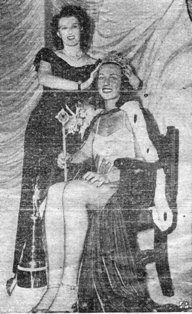
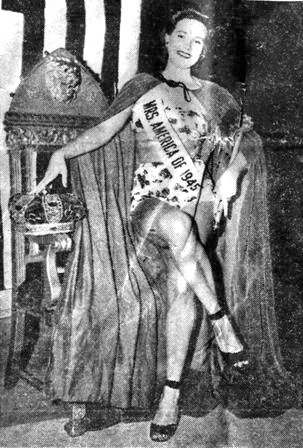
Miss America Reveals ‘All’ Concerning Winning Curves To NY Post's ‘Saloon Editor’ NEW YORK - (UP) - Earl Wilson, the New York Post's gift to Broadway baloney, interviewed Bess Myerson, 21, Bronx brunette who was the first New York dolly to cop the Atlantic City award of Miss America, and wound up with some revealing answers. ON NECKING The so-called "Saloon Editor" asked her, "Do you ever neck?" "A little sometimes - just from the neck up." "Are you a sweater girl?" "Oh sure, I wore them all through college." Now Wilson thought he was getting some place. "I notice you weigh 126 and have a 35½-inch fronts piece." La Myerson continued, "But I don't wear them tight. I wear them long and full." NO PADDING Then Wilson asked if she liked Frank Sinatra, to which she responded: "I can take him or leave him." Then Wilson got down to business. "Do you wear a brassiere?" "Yes." "Do you wear pads?" "No." (What a way for some guys to make a living.) BOTTLES UP, SGT. WELLS! DUDHKUNDI - When Top Kick William A. Wells squints his eyes and relates his adventures in the Far East to his grandchildren, no doubt his tales will be emphasized by the presentation recently made to him from his pals of the Twin Dragon Lightning squadron. The gorgeous presentation is a life-size replica of a
It seems Wells is an exceptional first sergeant in many ways and is well known throughout the Theater for his affable characteristics. Arriving in India in 1943, he was chosen to pick an enlisted team to form the now famous Twin Dragons, who were subsequently attached to the Royal Air Forces 224th Group in the Arakan. The Burma campaigning squadron is credited with 150 air victories. Bottles up, F/Sgt. Wells! COL. TELFORD TAKES COMMAND OF ROAD LEDO - Col. Edward T. Telford, QMC, today assumed command of Motor Transport Service, the organization in charge of all Stilwell Road convoys to Burma and China. Col. Telford, former commanding officer of the 468th Q.M. Group, and former Senior Highway Engineer, California Division of Highways, succeeds Col. C. S. Davis, who is returning to the United States. |
|
Gen. Thomas Terry To Take Over Reins
Lt. Gen. R. A. Wheeler prepared to leave his post as India-Burma Theater Commander this week, with Maj. Gen. Thomas A. Terry, former Second Service Command head, scheduled to take over.
Wheeler is returning to the U.S., where he will become Chief of Engineers of the Army. He has been overseas since 1941, being in Baghdad on Pearl Harbor Day. He first organized SOS in this Theater; moved to South East Asia Command as Principal Administrative Officer and was later appointed Deputy Supremo to Lord Louis Mountbatten. (Continued below)

Vol. IV No. 3 Delhi, Thursday, September 27, 1945 Reg. No. L5015
By SGT. JOHN McDOWELL Roundup Staff Writer
Enlisted men becoming eligible for discharge under the latest lowering of the Army's point system cannot be retained overseas as "essential personnel" unless they are listed under one of three designated specialist classifications, it was revealed by India-Burma Theater headquarters in Delhi this week.
Following announcement by Gen. George C. Marshall, Army Chief of Staff, that point totals required for discharge of enlisted men will be reduced to 70 on Oct. 1 and 60 on Nov. 1, India-Burma Army officials declared that men falling under these discharge categories will be returned to the United States as quickly as transportation facilities permit.
INTERPRETATION GIVEN
Asked if the Theater interpretation of the latest point ruling meant that an attempt would be made to get 60-point men back to separation centers in the States by Nov. 1 - time set for their becoming qualified for discharge - Brig. Gen. Francis Hill, Theater Plans and Training Officer, said:
"Enlisted men with 70 to 75 points will become eligible for return home on Oct. 1; enlisted men with 60 to 70 points will begin to proceed to ports of embarkation in India on Nov. 1. When the War Department order states that men in the 70 and 60 point groups will become eligible for discharge as of Oct.1 and Nov. 1 respectively, this means we have authority to start returning these men to the States on these dates."
ESSENTIAL GROUPS
The three occupational specialty groups which can be retained overseas for a six-month period despite point scores are orthopedic mechanic, encphalographist and transmitter attendant for fixed radio stations.
Although no figures are available on the number of enlisted men in the theater with 60 or more points, estimates placed the average theater point score, as of V-E Day, at 41 points. No figures on point averages as of V-J Day are yet available, but it is likely that the point average in this theater still remains 10 to 15 points under the ETO average, due to the scarcity of battle awards in India-Burma.
As regards officers in India-Burma, as of Oct. 1 all commissioned personnel, including field grade officers, with 75 or more points will become eligible for return home. If declared essential however, officers can be retained at their jobs a maximum of 60 days.
Meanwhile, the only bottleneck likely to occur in the movement of troops back to the States is transportation within the theater to ports of embarkation.
Transportation officers declared that Indian rolling stock already is being taxed the limit in moving American Army personnel and equipment to Calcutta and Karachi and British Army personnel and equipment to Bombay.
RAIL SHORTAGE
From the North Burma-Ledo area, it was reported this week that 18,982 Category Four men (troops with high point scores) assigned to Advance Section were scheduled to be moved to Karachi before Oct. 31. Of this total, railway facilities will permit only a maximum of 17,000 men to be moved into Karachi during this same period, indicating that there are more troops available and ready to move than the rail transportation facilities will be able to handle.
With overtaxed rail facilities threatening to effect a slowdown in the movement of eligible troops from the Assam area, ATC came to the rescue with a guarantee to provide air lift passage from Assam to Calcutta and Karachi during September and October for 12,000 troops monthly. Chabua will be utilized as the main base of operations for these troop movements.
Officials of ATC pointed out, however, that most of C-46 and C-54 cargo planes in this theater have been diverted to China to carry out the American mission of redeploying Chinese armies to zones of occupation. Thus, only a limited amount of plane space is available for the movement of homeward-bound G.I.'s to ports of embarkation.
Troops moving by rail from Assam to Karachi now spend eight days en route. Capacity of present trains is 500 men, but by mid-October the troop capacity will be stepped up to 670.
SHIPS EN ROUTE
With troopships scheduled to carry out the evacuation of troops during September and October already in port or en route to India, theater figures this week indicated that 15,500 men would move to the States during September and 46,000 during October. These figures include September and October shipments of China Theater troops totaling approximately 25,000. From September to December - when the port of Shanghai is to be utilized for troop evacuation - 40,000 China Theater troops are scheduled to be channeled through Calcutta.
Figures released by ATC officials revealed that 6,000 troops are scheduled to be returned to the States by air during September. In succeeding months the monthly quota will be cut to 1,500.
Among personnel returning by plane such categories as prisoners of war and emergency leaves will continue to get preference. Plane passengers, for the most part, will travel on a 3 priority, and will follow the standard North African passenger run. Stops will be made at Abadan, Iran; Cairo, Tripoli and Casablanca. Various runs branch out from Casablanca, with the planes usually ending their long hops in New York or Florida.
SHIPS PROMISED
Although troopships to carry out the evacuation of an estimated 35,000 troops in November and 45,000 in December have not yet been named, Gen. Hill said the War Department had indicated that ships to move these numbers would probably be sent to the theater.
Two types of troopships are being used in evacuating India-Burma: 3,000 and 5,000 capacity ships. Seventeen ships have been named to handle troop movements from Calcutta and Karachi during September and October.
Ships leaving Calcutta reach the East Coast of the United States in 26 days; those leaving Karachi make the trip in 21 days. Present ports of debarkation are Boston, New York and Hampton Roads.
Prior to departing for the port of debarkation, troops will be processed at their home station. At this time their clothing issue will be brought up to date, with new clothing issued when necessary. All will take overcoats - a practice which may seem ridiculous in subtropical India but which will bear fruit when the returnees reach the early winter climate of the East Coast.
MEDICAL CHECKUPS
Men will remain in the staging area at the ports of embarkation anywhere from seven to 21 days. At the staging area the men will receive 48 hour medical checkups and another brief half-day processing.
Although the present redeployment program in India-Burma could possibly see the last of the United States troops moved out within five and a half months, disposition of property and equipment may require the retention of troops in the theater for a longer period.
Units remaining in the theater to carry out this work will be composed of low-point men.
Surplus units are now beginning to move Stateward. It was pointed out, however, that in units declared surplus the high-point men return to the States with the outfit while the low-point men are replaced by high-point men from other units.
When asked what the main problem was that was keeping men in the India-Burma theater, Gen. Hill said, "When the war ended we just couldn't put on our coats and return home. There are still thousands of troops in China whom we have to supply. Those men will remain in China until their mission of assisting in redeploying the Chinese army is completed. And, until that mission is completed, the mission of India-Burma will not be fulfilled."
Wheeler Says Farewell To I-B; Terry New CG
Continued from top of page
He took over the India-Burma Theater in June following departure of Lt. Gen. Dan I. Sultan for the States. He was the official representative for the U.S. at SEAC surrender ceremonies in Singapore on September 12. Wheeler issued a farewell message to his troops in which he told how he had hoped to be in on the inactivation of the Theater as he had been in on its activation.
"It is with conflicting emotions that I leave the India-Burma Theater," he stated. "Naturally, I am anxious to begin working on my new assignment as Chief of Engineers. But my roots here are very deep. In more than three and a half years out here I have made many friends, undertaken many tasks, some of which are still incomplete, and this makes leaving difficult."
The Theater Commander continued:
"I was here when this Theater was first activated and had hoped to be here when it was finally inactivated. I participated in its growth, developed a profound respect for its personnel and a deep admiration for their outstanding accomplishments under the severest conditions of climate, terrain, and disease.
"When I assumed command of the Theater last June, we had an arduous mission to fulfill. The courage, skill, and determination with which is was pursued has made me proud of the privilege of having commanded such gallant men and women, and humble in the face of the sacrifices they made in order to get the job done.
|
"I promised then that I would continue the policy of getting you home as soon as you could be spared and as fast as transportation could be made available. That I have done, and today, as many men are leaving here as available transportation can carry.
"You of India-Burma have made a glorious record and a material contribution toward our triumph. I am sure that when you once again become civilians or re-enlist in the Armed Forces you will put the lessons learned here to the best possible use and make this a better world, which after all, is what we have worked, fought and died for."
The new Theater Commander, Gen. Terry, was responsible for defense of New York City and surrounding areas during the major part of the war. He was charged with carrying out the War Department rulings for defense precautions along the Atlantic Coast in the spring and summer of 1942, when U-boats were prowling off the coast.
Terry served in several major posts in the nation since his graduation from West Point in 1908. From 1908 to 1918 he served in the U.S. Panama Canal Zone and the Philippines. During World War I he served in France with the 58th Coast Artillery. He received the Victory Medal in 1919.
After the war he was successively assistant commandant of cadets at West Point and executive officer of harbor defenses at Manila. He took command of the coastal defense area of New England and later the First Corps area, including Boston. He went from there to the Second Service Command.
He was born in Alabama on Nov. 22, 1885.
Occupation Plan For Japan Has Drastic Changes
Roundup Staff Article
The White House released this week the formula for the occupation of Japan, based on the instructions issued to Gen. Douglas MacArthur on August 29, even before the signing of the formal surrender.
The formula calls for changes in the Japanese economic, political, and social systems, including breaking up of the great family monopolies which dominate Nippon's trade and industry.
JOINT DECLARATION
The declaration, prepared by the State, War and Navy Departments and approved by the President, instructs MacArthur "to use" the existing form of government in Japan, not support it. It adds, "This policy does not commit the Supreme Commander to support the Emperor or any other Japanese Governmental authority. American forces are directed to favor changes in the Japanese Government initiated by the people or Government in the direction of modifying its feudal and authoritarian tendencies."
The statement also says every effort will be made to establish policies satisfactory to the principal Allied powers, but in the event of difference of opinion "policies of the U.S. will govern." It advises MacArthur that the U.S. will follow a policy of dissolution of large industrial and banking combinations."
REPARATION PLAN
Reparations for Jap aggression are to be made through transfer of Japanese property outside the home islands. The doctrines of militarism are to be eliminated from the educational system. Japan is to be stripped of all military and civilian aviation and secret police. Exports and imports will be under suitable control, presumably by the U.S.
The document gives as the objective of the occupation the bringing of Japan to a point where it will no longer menace the U.S. or the rest of the world and will have a responsible government as reflected in the United Nations Charter.
Previous to publication of the Washington document, MacArthur aroused a storm of controversy in the States and abroad by stating that 200,000 U.S. troops would be sufficient to garrison Japan. This brought a sharp statement by acting Secretary of State Dean Acheson stating that "the occupation forces are instruments of policy and not the determinants of policy."
COMPLETE COLLAPSE
MacArthur made no reply to the State Department blast. But he did give an interview to the United Press in which he stated that Japan would never again be a world power. He said Japan is in a complete state of collapse and her punishment will be long and bitter. He said that the Jap Army would be abolished by October 15, that the surrender terms are being rigidly enforced and that Japan can expect no help in the form of food or relief this winter.
Answering charges in the States that he had made his 200,000 occupational statement because of political motives, MacArthur said he was on his last public assignment and had no political ambitions. He said it would take many years to fulfill the terms of surrender.
MacArthur also told a Texas newspaperman that Japan would be too busy trying to find enough to eat in the next 25 years to even think of rearming.
DOIHARA TAKEN
MacArthur cracked down on the Japanese naval police, ordering their immediate dissolution. He also ordered the immediate arrest of Lt. Gen. Kenji Doihara and issued a 10-point plan for censorship of the Jap radio and press. The Jap general was later taken into custody by the Eighth Army.
The Supreme Commander cracked down on Tokyo's biggest newspaper, Asahi, suspending it for two days after it mocked the U.S. order not to print atrocity stories.
FIRST SHIPLOAD OF 3,000 TROOPS LEAVES KARACHI
KARACHI - The first shipload of U.S. Army troops - approximately 3,000 officers and enlisted men - to be evacuated from the I-B Theater by water through the port of Karachi left the morning of Sept. 24, aboard the General McRae, according to an announcement by Port Commander Col. S. C. Hilton.
The sailing of the General McRae marks another step in accelerating the movement of 250,000 American troops back to the U.S. This is in accord with the Theater policy announced on V-J Day, that the tremendous task would be accomplished as rapidly as possible.
According to the plans which are now being put into operation U.S. troops are to be evacuated from the I-B Theater at the rate of approximately 40,000 per month, half through Calcutta, half through Karachi.
Approximately 1,500 per month will go by air from Karachi and 20,000 from Karachi by water. In order to facilitate this water movement the port of Karachi was activated on Aug. 31.
The General McRae, one of the C-4 type transports, arrived in the east wharf of Karachi Port last Saturday. The troops to go on this ship had already been processed by Replacement Depot No. 1 at Malir. Throughout Sunday, they passed through the city in truck convoy on their way to the docks. Loading of troops and equipment was accomplished in seven hours.
Ships of the General McRae type are relatively fast, being capable of between 17 and 18 knots. At this speed, the long voyage home should take about 20 days. Arriving in Karachi fully provisioned and fueled, they require only 36 hours for turnaround. Four more ships of the General McRae type are scheduled to enter and leave the Karachi Port of Embarkation within the next three weeks. Larger ships, capable of accommodating 5,000 troops each, are scheduled for arrival later in October.
|
Roundup Staff Article
A "red apple" Army and Navy recruitment bill unanimously passed the House this week and is now in the hands of the Senate for consideration.
At the same time, India-Burma Theater Headquarters has received official War Department notification that enlisted men of the first grades will receive a re-establishment bonus of $50 for each year of service since their last previous enlistment, and those of the last three grades $25 for each year.
The bill now pending in the Senate, however, provides a re-enlistment bonus of $50 for each year of service for all enlisted men, regardless of grade.
In a determined effort to make brighter the Army and Navy picture for re-enlistment, the bill passed by the House contains a number of encouraging features.
TRAVEL PAY
It includes inducements such as (1) travel pay of five cents a mile for 90-day furloughs for those who re-enlist; (2) free mailing privileges; (3) continued 20 percent extra pay for overseas service; (4) enlistments for only two years if the recruit wishes; (5) optional retirement after 20 years of service instead of 30; (6) option of taking mustering-out pay before re-enlistment instead of waiting until the end of the new enlistment period; (7) extension for the period of re-enlistment of the time a veteran may avail himself of the benefits of the G.I. Bill of Rights.
The Associated Press said that the measure, which was written by the House Military Affairs Committee, is an effort to sidetrack proposals to halt inductions and force speedier demobilization. Indications are, however, that it might touch off a battle over the draft and present discharge systems.
The idea behind the bill is that if enough men re-enlist, inductions can be stopped sooner and veterans still in uniform can be mustered out more rapidly, and in larger numbers.
RED APPLE
"It's a sort of red apple we're holding out to men to stay in the service," said one Military Affairs Committee member.
Committee Chairman Andrew May (D.-Ky.) expressed the opinion - backed up by Congressional experts - that proposals are out of order to amend the bill in the Senate so as to halt the draft and to force the Armed Services to discharge fathers and men with two or more years of service. Reason: The bill is intended specifically to get men into - not out of - the Army.
|
Gen. Wheeler's Daughter Serves With OSS In SEAC; Discusses Enlisted Men By SGT. ART HEENAN Roundup Staff Writer |
KANDY, CEYLON - Hollywood's favorite cinema plot, back in the days when one could speak of the draft without planning to blast his Congressman out of office the next election, invariably included a scene in which an enlisted recruit, talking to an attractive looking gal, suddenly discovers she is the general's daughter.
The same scene took place this week here at the lush headquarters of Lord Louis Mountbatten's Southeast Asia Command, with myself as the enlisted man. Since I have more number of months overseas than the average war worker has overtime checks in the bank, I can hardly qualify as a recruit, and the plot is further reversed as I knew in advance the girl was the general's daughter.
The general in question is three-star R. A. Wheeler, commander of U.S. Forces in the India-Burma Theater and Deputy Supremo of SEAC. The daughter is named Margaret Irene, which she "only uses to sign checks" and is better known as Peggy. She won't know this until she reads it here, but most of the enlisted Yanks at SEAC call her Margy.
Miss Wheeler is with the Office of Strategic Service here, having arrived in May, 1944. I was introduced to her by Gen. Wheeler as we stopped off enroute to Delhi from the Singapore surrender.
WITH LOSS
Her presence in the command of which her father is also Deputy Commander did not evolve from a plot brewed in the seats of the mighty. Gen. Wheeler quite proudly states that his daughter got herself over here through personal initiative and that the first he knew about her coming was a hurried scrawl from New York.
"I had been working with OSS since May of 1942 in New York City," explained Peggy or Margy, with just a tinge of New York accent in her even tones, which we are glad to report still retain the hard "a's" of America. "I asked for overseas duty and they gave me my choice of assignment as is customary in most cases. Naturally, I asked for this area, since my father was here, and I wanted to be near him. I didn't know whether I would be assigned to India or Ceylon, but as it happened I was sent to Kandy."
"I warn you that I can't sing, play the piano or paint," she laughed. "I don't think that anything I would have to say would be of much interest to soldiers."
I assured her that anything any American girl had to say was of interest to G.I.'s in the India-Burma Theater, and that the setup in the land of monsoon and baksheesh was totally different than Kandy, where NOT to have a woman around was news. She laughed at the bluntness of contrast implied and said her father had oftimes described to her the rigors American troops in the I-B have to undergo.
What did she think of the G.I.'s that have carried the spirit and laughter of America to the Orient.
'EXCEPTIONAL MEN'
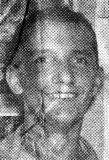 Champion of all India-Burma Army Air Force chess players is Sgt. Joseph Balint, of the 333rd Airdrome Squadron,
Barrackpore. Balint copped the title in a recent contest held at Hastings Mill.
Champion of all India-Burma Army Air Force chess players is Sgt. Joseph Balint, of the 333rd Airdrome Squadron,
Barrackpore. Balint copped the title in a recent contest held at Hastings Mill.
|
"The only ones I know are the men who work in our office here," she explained. "They are an exceptional bunch of men. I do know from comments that other members of the Allied forces have been struck by the individual kindness of the American soldiers in India towards the poor. Frankly, put the Army back in civilian clothes and I couldn't tell the difference between officers and men."
(The enlisted men who play in the band here say Miss Wheeler is extremely considerate of them at dances, complimenting them on their playing and making sure they have enough to eat and drink. One saxophone player said, "I'll bet she wasn't brought up around any Army posts. Nothing stuck up about that gal.")
(The musician was right. Miss Wheeler spent most of her life in cities, since her father is in the Engineers.)
I asked the General's daughter if, from her own observation, American girls had a tendency to become high-hat once they arrived overseas. Did they refuse to be seen in public with anyone boasting less than a chicken on his shoulder?
"My opinion is that American girls haven't changed," she replied after some hesitation. "If a girl reacts that way over here, she was the same before she left the States." By which you can see that diplomacy was part of her course at Vassar.
'CHEESECAKE O.K.'
Did she think that cheesecake was a good thing in the Roundup? I explained that we had taken polls among the men but had neglected to ask any of the fair sex if they thought it objectionable.
"Of course it isn't objectionable," she warmly answered. "It's a natural thing in America and the men should get cheesecake if they want it, and they evidently do since it seems to be one of the Roundup's main commodities. American girls understand American men and we see nothing unusual in their approval of cheesecake. In fact, if they didn't want it, I'd say they'd changed a lot."
We will conclude with the information that the daughter of the Theater Commander has at least one thing in common with all of us. She wants to go home too.
I-B PONTON ENGINEERS FIGHT MONSOON FLOOD
By SGT. C. M. BUCHANAN Roundup Field Correspondent
ALONG THE STILWELL ROAD - Two husky soldiers, muscular, fit, and stripped to the waist, leaned over the side of the ponton bridge and peered at the water gauge. "She's coming up fast," the bigger fellow said. "Yeh, a foot in the last couple of hours. Looks like trouble in a big way," the other returned.
And there was trouble coming. Tons and tons of mud, rushing water, swirling and spewing as it lashed the jutting banks and skidded over sharp rocks. Branches of trees, chunks of wood, strips of bamboo and entangled
|
To the Ponton Engineers this was to be expected, for this was the height of the monsoon season. Nature was dropping its annual deluge on Assam and northern Burma, two of the wettest spots on earth. The skies opened and walls of water dropped on the jungled, precipitous mountainsides. And the water, gaining in fury as it descended into the valleys, turned rivulets to streams, streams to torrents, and torrents to twisting, raging rivers that brought down trees and vegetation in a thundering rush.
FAST WORKERS
Such is the experience of the Engineer Light Ponton Companies that grew up with the Stilwell Road.
During the summer the 400-foot steel bridge over the Mogaung at Warazup, battered and beaten by racing, debris-filled waters, produced overnight by a flash flood, gave way and tumbled its spans into the river below. Ponton Engineers rushed from Ledo and Myitkyina. In less than two and a half days, an 18-ton bridge spanned the river and cargo convoys laden with important supplies for China, rumbled across.
One of the first two Engineer Light Ponton Companies to arrive in the India-Burma and China Theaters was the 76th. Rather than being unusual, among ponton engineering outfits, they are typical. Their performance, like that of other ponton companies, has been varied, important and versatile.
The 76th, composed of white officers and Negro enlisted men, has earned a splendid record of achievement in its two years overseas. Soon after arriving in the Ledo area late in 1943, it was assigned to work with the 382nd Engineers who were building the Ledo air strip. later they proved their versatility by pitching in on pipeline construction and helped lay the line from Digboi to Mile 0 on the Stilwell Road.
The first job for which the 76th had been trained, came in February, 1944, when it was rushed to Yubang, Burma, and there working feverishly, threw the first ponton bridge across the Stilwell Road, replacing a crude, primitive bamboo foot-bridge used by Chinese troops and Merrill's Marauders as they pushed deeper into Jap-held territory.
FASTER WORK
With the Japs on the south side of the Tarung River, men of the 76th ignored Nip artillery fire and installed a ponton bridge 470 feet long in one and a half hours, enabling infantrymen and equipment to move across the structure to rout the dug-in Japs.
Then came a lull in the excitement, but not in the contribution these men made to the pushing ahead of the important Stilwell supply artery. While one platoon maintained the newly constructed Tarung River bridge, the remainder of the outfit pitched in on a gravel hauling job to surface the highway before the rains came.
Later another ponton bridge was installed across the Tawang River and a platoon took over the maintenance of fifteen miles of combat trail from Ningham Sakan to the Tarung River.
Late in May, 1944, the ponton soldiers moved five miles south of the Tanai River and took over the maintenance of a bridge built by the 71st Engineer Light Ponton Co. Early in June a flash floods swept away the ponton structure and a ferry service consisting of pneumatic pontons, propelled by hand, was started as an emergency measure, but soon abandoned when the river continued to rise and flow more swiftly.
FLEE CAMP
It was at this point that the men were forced to flee from the camp as the rising waters threatened to inundate the entire area. Hastily departing, they moved bag and baggage across the Tanai by assault boats and set up shop on the north bank.
One platoon spent a month evacuating equipment from the combat trail as the rains continued to flood the flat valley lands. Four bridges were constructed along the combat trail to enable the trucks to move, so deep was the water.
Early in July a detail began cutting and capping piles for the emergency causeway south of the Tanai River and shortly after, working with the 71st Engineer Light Ponton Company, the two organizations constructed a 775-foot bridge in 11 hours across the Tawang River.
FIVE A DAY
But the variety of work did not stop there. On July 22 last year, a detail of 35 men began operating the Burma Waterways, one of the most unusual tasks ever to confront a ponton company. The monsoons hit northern Burma in all their fury turning the newly cut road into a hopeless quagmire. In the Hukawng Valley, stretches of the road went completely under water. Air dropping was reduced to a minimum because of the treacherous weather. Convoys of trucks battled the mud and water to carry supplies forward.
A river service was started in which five boats a day carried supplies to men isolated in forward sections of the road. Consisting of assault boats with outboard motors, some ingeniously rigged up to carry a maximum load, the craft started at the Lamonge River, twisted up and across the Tanai, then up the Nambu River to the Namchec, backdoor to our important sub-depot at Tingkawk Sakan. It was a dangerous, difficult trip; but the experienced watermen delivered a maximum of supplies with a minimum of losses during the height of the rainy season.
While this was going on, another detail of men began logging operations at Mile 108. They helped the saw mill soldiers cut, drag and saw timbers badly needed for road and building construction.
CLEAR DEBRIS
A little more than a year ago, the entire outfit made a mass movement by air. Shortly after the fall of Myitkyina, Engineers were needed to clear debris from the shell-scarred and bomb-shattered northern Burma city. The 76th Light Ponton Engineers flew from Shingbwiyang to Myitkyina and in the process, four men of the company were lost in a plane crash. At Myitkyina, the outfit performed a variety of engineering duties, including road maintenance, building construction and operation of the Waterpoint. One officer was in charge of a bomb disposal detail in Myitkyina and vicinity, removing and disposing of duds, booby traps, and land mines.
After performing a wide variety of building operations in the newly captured northern Burma town, including grading, ditching, pouring concrete, and prefabricating structures for the 18th General Hospital, the entire organization moved to Ledo where they removed an old wooden ponton bridge and erected a new steel ponton structure across the Dihing River near Margherita, Assam.
MAINTAIN BRIDGE
This summer, in addition to engineering jobs around the base, the 76th maintained the Dihing River bridge against the sweeping monsoon waters. Though the boys admit the work is less enduring and more routine than formerly, it still is not without danger. On July 22 of this year, Pfc. Walter J. Fields of Moundsville, Ala., was swept to his death in the rushing waters of the treacherous Dihing as he was helping secure a ponton cable to keep that important bridge open. He is the latest of seven men of this company to give his life while serving along the Stilwell Road.
I-B MEN PLAN USE OF SCHOOL BENEFITS OF BILL OF RIGHTS
By CPL. CHET HOLCOMBE Written Especially for Roundup
Recent Stateside reports on the number of veterans taking advantage of the G.I. Bill of Rights' educational provisions have been rather pessimistic. But, judging from an informal survey that this reporter made, men of the I-B Theater are planning to take full advantage of the free education offered them when they get home.
Most of the men discharged so far have generally been disabled and older in years, but as younger men in any number start wearing pinstripes the number of students benefiting from the G.I. Bill will certainly increase. Men who are not now planning education may change their minds when they get home because they have two years after date of discharge to commence study.
A large percentage of the younger group of soldiers that this writer talked to are planning to take some kind of training at Uncle Sam's expense. And of the men above the age of 25, a surprising number said they expect to take some kind of training or refresher courses, since every veteran is entitled to at least one calendar year of education.
MP FOR MUSIC
As Capt. Charles Bodle, I and E officer for the Replacement Service, told me: "If a man doesn't take advantage of the free education offered veterans after this war, he's a damn fool!
Cpl. Romie Nentwig of Saginaw, Mich., veteran of Africa, Italy, Sicily and South France, and now with the 153rd MP Service Co. at Ledo, says he is going to Interlaken, Mich., for a music refresher course. He was a featured accordionist with the Ted Fio Rito and Henry King orchestras.
Capt. James W. Thurman of Benham, Ky., I and E Officer, 1348 AAF Base Unit in Myitkyina, says he is going back to the University of Kentucky to finish his master's degree in education.
Pfc. George Cieplick of Wilkes-Barre, Pa., at Replacement Depot No. 5, Chabua, declares he is going to take a year's course in electricity. "There's a great future in that field," Cieplick asserts.
Cpl. Rex C. Brown, Camden, Ark., of the 3101 Signal Service Battalion at APO 488 studied for a year at the University of Tennessee. Now he is planning to attend the University of Pennsylvania to study business administration "along with three buddies."
NO BOOKIE STUDY
"A good North Carolina university" will be chosen by Pfc. Thomas C. Bray of Rocky Mount, N.C., now serving with the 1333 AAF Base Unit, Chabua. He has been pursuing USAFI courses in business.
There was one man among those interviewed, however, who said G.I. education couldn't teach him a thing in his line. S/Sgt. Edgar Terriault of Lowell, Mass., stationed at Replacement Depot No. 5, Chabua, a race track bookie in civilian life, said that he can't find any courses taught on bookmaking in any U.S. school.
Photography studied in the Army has interested Cpl. Harold Frazer of Beckley, W. Va., stationed with MTS Headquarters in Ledo, in adopting it as a profession. He will enter a school for photographers when discharged.
Although he is 28, Pvt. Robert Richards, Negro, of Cleveland, O., stationed with the 3648 QM Truck Co. in Ledo, asserts that he is going to a school to specialize in aviation engines. His work with automotive engines in the Army, he says, prompts him to leave his former work with a meat packing concern.
STUDY JOURNALISM
A radio operator with the 317th Troop Carrier Squadron, 2nd Air Commando Group, S/Sgt. Robert O. Utter of Memphis had just flown into Ledo from China when he talked to me. He said that he will go to Southwestern University, Memphis, for a journalism course.
The draft interrupted Cpl. Ray Guaradello's plans to take a law course. But this Stockton, Calif., graduate of Stanford University is determined to carry on his law career some way, although he is entitled to only one year of gratis education under the G.I. Bill. He's stationed in Ledo as a refrigeration expert.
Cpl. Sidney Kotler of St. Louis, an artist with the Theater I and E Orientation Section, Delhi, is planning to continue his art studies in the East when he gets home. He illustrated the pamphlet, Stilwell Road, the story of the Ledo Lifeline.
Pfc. William J. Schickler of Erie, Pa., a member of Buck Sheet on the Ledo Road, is planning to enter a university course for foreign service. He is a member of the 18th Special Co. in Ledo.
Stationed at Lalmanir hat, Sgt. Sam Jacobs of Grand haven, Mich., is a member of Squadron B, 1326 AAF Base Unit. Marriage is the first item on his civilian agenda Jacobs says, and then he's going to work days to support his little family and go to Wayne University at night to study accounting. He is catching up on business practices now with USAFI.
ACCOUNTING INTEREST
Despite the fact that he has a good job waiting him, T/Sgt. Kenneth L. Curtis of New York City, stationed at Myitkyina, declares that he is going back to school to study advertising. Curtis has fixed up his tent to compare in comfort, luxury and good taste with any other tent in the Theater.
A career as a professional dancer is planned by S/Sgt. Willard F. Purcell of Alton, Ill., who has been stationed at Hastings Mill. He plans to take advantage of the G.I. Bill.
Pfc. Charles Warerman of Philadelphia, staff artist on Top Kick, the daily newspaper of Replacement Depot No. 5, says that he plans to enter the Philadelphia Art Institute as a G.I. Bill student after he gets home.
Many instances of men, mostly 25 years of age and older, could be quoted as saying they are not interested in going back to school. It is to be expected, because the older group are generally already trained and well into their life work.
We've heard no reports of generals in this Theater planning to go back to school. But a lieutenant colonel and a full colonel each told us they were planning refresher courses in their peacetime professions, even though officers above the grade of captain do not receive the benefits of the G.I. Bill.
RESCUED B-29 AIRMEN RELATE GUERRILLA LIFE
|
Shot Down In Malaya On Jan. 11
By SGT. ART HEENAN Roundup Staff Writer
SINGAPORE - Amid the fantastic adventures that have befallen American airmen in this war is the saga of three India-based B-29 officers, shot down over Singapore, January 11, and saved by Chinese guerillas, who gave them refuge until word of the Jap surrender came.
The former CBI men were Maj. D. J. Humphrey, Postville, Iowa; Lts. W. F. Duffy of Chicago and E. C. Salzman of Washington, D.C.
I talked with the Superfort airmen at the Raffles Hotel here the night that they drove into the city in a black Cadillac sedan, which they had taken along with a sultan, after throwing up a road block on a Japanese party, killing five of the Nips, and taking the sultan and his limousine along in protective custody.
Humphrey, the plane's pilot and the man who piloted the first B-29 over Japan in a raid from Chengtu, China, on the Yawata Steel Mills on Kyushu, started the story. Lean, saturnine looking Humphrey, with a scar on the side of his face and looking like a Hollywood character, told how his plane arrived over the target on January 11.
PHOSPHOROUS BOMBS
"We were at 15,000 feet and had been separated from the rest of the formation due to bad weather," said Humphrey. "Duffy saw a B-29 ahead of us and said he saw it disappear in an explosion after it was rammed by a Nip fighter." Duffy nodded his head in confirmation.
"There were fighter planes all around us," continued Humphrey. "I'd say there were between 30 and 40. They were dropping aerial phosphorous bombs and machine-gunning. There was plenty of ack-ack. Some bullets came through the cabin, depressurized it and wounded the co-pilot. Further hits knocked two of our engines out and the rudder was damaged. I ordered oxygen masks out and put her on automatic pilot.
"I received word that one of the wings was on fire. I ordered the crew to prepare to jump. Before I could give the order the wing fell off. We all managed to get out. I fell into a tree, but Duffy heard me shout and cut me down."
Duffy then took up the story. "I joined up with Salzman and T/Sgt. Ralph Lindley, one of our gunners, on the ground. We spotted a Malayan and told him we were Americans and wanted to go where there were no Japs. He led us down the trail. We saw some Malayan policemen so made him turn around."
Salzman took up the burden. "We finally ran into a village headman. He spoke English and said he would help us. He found us a hiding place off the trail and told us to wait there until 23:00. He told us not to stir until we heard a tune being whistled, as there were a lot of birds around, and if we rushed out we might run into Japs."
CHINESE GUERILLAS
The men related how their friend had come back about 23:30. He had a Chinese guerrilla and his girl friend with him. The guerrilla and the girl then led the Americans through the night. Next day as they were resting by the trail they spotted Japs approaching. Sgt. Lindley rushed down the trail right into the hands of the Japs.
(It developed afterwards the rest of the crew had been captured after parachuting from the plane.)
"That Chinese guerrilla and girl really took off," drawled Humphrey. "We knew they were our only hope so we followed. We came to a creek and had to jump from one log to another to get across. The girl fell in and was lying there crying. Salzman went back and hauled her up, carrying her over to the other bank."
"We ran as long as we could and then finally I made the guerrilla stop," related Humphrey. "I had to grab him. There was no sign of pursuit. I don't know how we got away so easily, but I suspect the Japs thought Lindley was the only member of our party."
72-HOUR MARCH
"While we were resting, the guerrilla decided to show us his political convictions," said Duffy, with a lop-sided Irish grin. "First he showed us a picture of the Kremlin, then he said, "Me Commie." Then damned if he didn't take a piece of Jap paper money from his pocket and go through the motions of what people do after they perform an act of nature in a latrine. He wanted to make sure we understood his feelings towards the Japs."
For about 72 hours the Americans and their Chinese guides kept on the march. At the end of the third day the guerrilla, whom the airmen called George, because he was so much like an automatic pilot, led them out into the same clearing into which they had parachuted from the B-29. He had been leading them in circles to confuse the Japs.
The party soon arrived at advance guerrilla headquarters, which Salzman said was a well laid out camp near a rubber plantation. A boy there spoke good English and said the Chinese would look after and protect the Americans. Humphrey explained that this headquarters was a money collecting agency, with commissars going into nearby villages for contributions.
WRITE LETTERS
The commandant was half Chinese and half Jamaican. He permitted the Yanks to write a letter to Communist headquarters asking if they could go there and make contact with some British and an American OSS officer reported to be in Malaya.
For a month the Americans waited at this camp for a reply.
"Talk about channels," groaned Salzman. "Boy, those guys had any Army stopped. All communications had to be okayed by men from the rank of cook up." Duffy was taken ill there and the Yanks were finally moved to a regimental headquarters.
Here the airmen were permitted to write another letter, this time to a headquarters lower than that of the top Chinese commander. Then they had to sweat out the answer.
"We had rice and tapioca. The CO ate chicken and steak," said Humphrey. "He regarded the U.S. as a capitalistic country and thought we were beyond hope. Once in a while he cut everyone's meals to two a day. We'd catch him sneaking down at night to get something extra for himself though."
YANKS PROCEED
After a stay of five weeks at the regimental headquarters, the Yanks were finally allowed to proceed to what they called Third Regiment Headquarters.
"It was a long hike over swollen streams," said Duffy. "We had three Chinese guides. And do you know two of them couldn't swim and the third would never break any records. We had to rescue them twice. Don't ever let anyone tell me that the Chinese haven't got guts."
They said this was the least political of all the Communist camps. These men were out simply to fight. "They didn't try to convert us, unlike the other camp. On April 28 we received a letter from the American OSS officer. It had been written January 20 and had been all that time clearing the Communist channels," explained Humphrey.
The next move was to the Sixth Regiment Headquarters. Here the Yanks were frequently lectured on the benefits of Communism. "I still dream of that pet phrase of theirs, 'There are five stages of men and Communism is the zenith,'" said Duffy. The Chinese commandant here told them he was opposed to all British and Americans because they were all capitalists.
JOIN BRITISH
"I finally made it clear we were not interested in politics," explained Humphrey. "I told them I was an Allied officer and gave them five days to put me in direct touch with the American officer or British detachments that were operating there."
The Chinese commandant finally agreed and the Yanks joined the British detachment. They were with the British until the news came of the surrender.
The men were members of the 468th Bomb Squadron of the 20th Air Force, then under Maj. Gen. Kenneth Wolfe. They had taken off from Karagpur on their Singapore mission.
Next day they left on an ATC plane for the U.S. Before leaving they received word that the other members of their crew, who had been captured, had been rescued from Jap prisons.
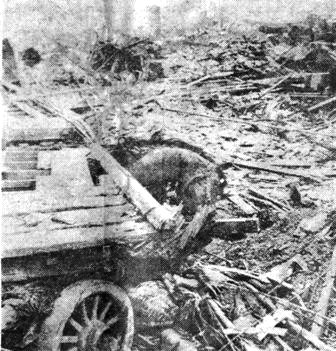 Every living thing from man to insect as well as every inanimate object from palace to shack is a target for
the deadly atomic bomb, which draws no lines as it spreads destruction in a huge circle about the target spot.
In Nagasaki on the day atomic death rained from the skies, the body of a horse lies amid the hopelessly shattered
ruins. The picture was made by a Jap civilian.
Every living thing from man to insect as well as every inanimate object from palace to shack is a target for
the deadly atomic bomb, which draws no lines as it spreads destruction in a huge circle about the target spot.
In Nagasaki on the day atomic death rained from the skies, the body of a horse lies amid the hopelessly shattered
ruins. The picture was made by a Jap civilian.
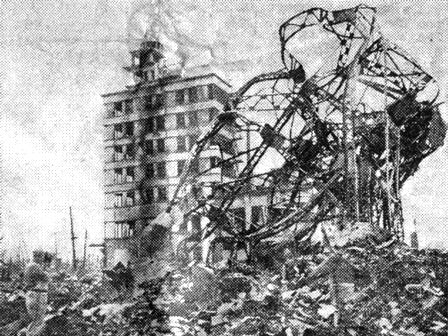 Steel girders that were twisted into grotesque shapes by the bomb's tremendous power is what remains of a modern
building in Hiroshima. The building in the background, though gutted, miraculously escaped being pulverized.
Bounding both buildings are acres of scorched land.
Steel girders that were twisted into grotesque shapes by the bomb's tremendous power is what remains of a modern
building in Hiroshima. The building in the background, though gutted, miraculously escaped being pulverized.
Bounding both buildings are acres of scorched land.
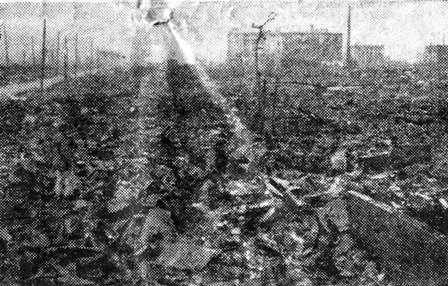 A two-foot layer of twisted tin and rubble marks what was the industrialized city of Hiroshima. All that remains
standing for block after block are fire-blackened trees. Spotted here and there are shells of buildings which
escaped being pulverized.
A two-foot layer of twisted tin and rubble marks what was the industrialized city of Hiroshima. All that remains
standing for block after block are fire-blackened trees. Spotted here and there are shells of buildings which
escaped being pulverized.
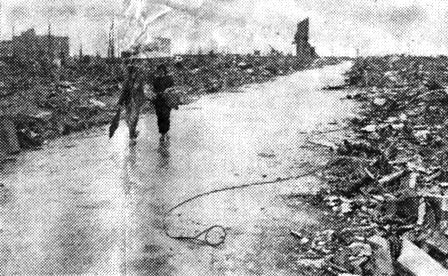 Two Japanese civilians walk through a cleared path in Hiroshima bounded on both sides by a mass of rubble
resulting from the atom bomb's blast.
Two Japanese civilians walk through a cleared path in Hiroshima bounded on both sides by a mass of rubble
resulting from the atom bomb's blast.
|
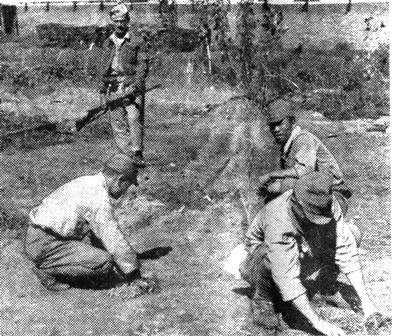 Following their recent liberation, former American POW's wasted little time in "changing commands" of the prison
camp at Mukden, Manchuria. Above, Cpl. William E. Adams, captured on Bataan in 1942, sees to it that his ex-guards
"police the area" properly.
Following their recent liberation, former American POW's wasted little time in "changing commands" of the prison
camp at Mukden, Manchuria. Above, Cpl. William E. Adams, captured on Bataan in 1942, sees to it that his ex-guards
"police the area" properly.
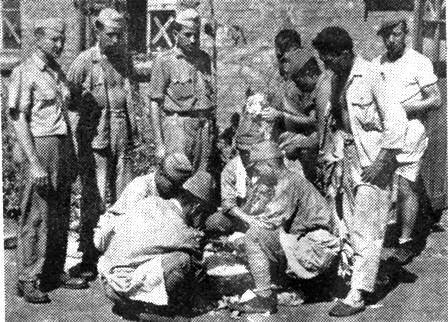 Some of the best entertainment in the ex-Jap prison camp in Mukden is watching former Nip guards doing K.P. for
liberated Allied prisoners. Enjoying the sight above are: left to right, Col. R. G. Rogers, Cpl. D. B. Tooney,
Sgt. Andrew Prenznak, Pvt. D. Brooks (British Army) and Coxwain T. J. Reardon.
Some of the best entertainment in the ex-Jap prison camp in Mukden is watching former Nip guards doing K.P. for
liberated Allied prisoners. Enjoying the sight above are: left to right, Col. R. G. Rogers, Cpl. D. B. Tooney,
Sgt. Andrew Prenznak, Pvt. D. Brooks (British Army) and Coxwain T. J. Reardon.
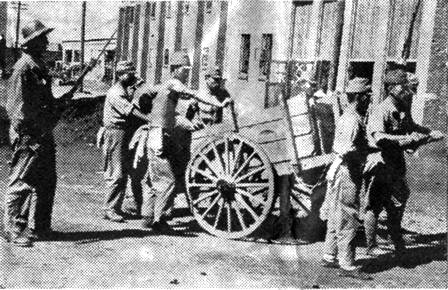 The shoe's on the other foot these days and Cpl. Manuel Chacon stands guard over his Japanese charges to see
that it pinches just a bit. Chacon was captured in the Philippines and brought to Mukden.
The shoe's on the other foot these days and Cpl. Manuel Chacon stands guard over his Japanese charges to see
that it pinches just a bit. Chacon was captured in the Philippines and brought to Mukden.
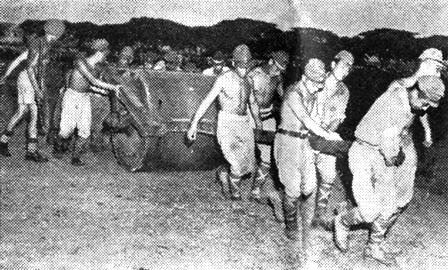 These Japs, pulling a heavy roller, get the parade ground ready in front of the Municipal Building in Singapore
in preparation for surrender ceremonies the next day. The British guard would work the Japs until they fell out
exhausted, then he would get more Japs.
These Japs, pulling a heavy roller, get the parade ground ready in front of the Municipal Building in Singapore
in preparation for surrender ceremonies the next day. The British guard would work the Japs until they fell out
exhausted, then he would get more Japs.
|
ATC FLIES 1,000 POW'S FROM ASIATIC CAMPS
CALCUTTA - Immediately following the signing of Japanese surrender terms the India-China Division of ATC evacuated approximately one thousand American prisoners of war from Asiatic prison camps.
In one of the outstanding mass aerial evacuations of the war, ICD aircraft, staffed with surgeons, flight nurses, and medical supplies, evacuated POW's from Jap prison camps near Rangoon, Bangkok (Thailand), Saigon (Indo-China), Singapore and Northern China.
 Meet the Wolf, most-hated Jap prison guard in Manchuria. Liberated Americans told Roundup correspondent
Sgt. Fred Friendly that the Wolf took great delight in beating U.S. POW's. Friendly interviewed this character
last week.
Meet the Wolf, most-hated Jap prison guard in Manchuria. Liberated Americans told Roundup correspondent
Sgt. Fred Friendly that the Wolf took great delight in beating U.S. POW's. Friendly interviewed this character
last week.
|
First priority was given this mission of mercy in order that American soldiers and sailors and interned civilians, some of whom had been held captive for almost four years, could receive proper medical attention at the earliest possible moment and begin their homeward journey as rapidly as possible once they had been freed.
The urgency of the mission sent ICD pilots, doctors and nurses into Jap-held airfields where reception was more than a little doubtful. The survey flight which led the way into Singapore resulted in an ICD ship being the first Army Air Force aircraft to land at that city after its formal surrender by the Japs. In other sections, ATC was close behind the first American forces which arrived to round up the prisoners of war and to prepare for their evacuation to assembly points.
In this mass movement of war prisoners, ICD maintained a spotless safety record. In spite of the lack of radio facilities, weather reports and accurate maps all the prisoner-of-war missions were accomplished safely without a serious mishap.
Because of the uncertainty of the situation the first survey flights maintained radio contact with their headquarters base every fifteen minutes.
The C-54 which was flown on the first flight to Singapore was serviced with sufficient gasoline to cover the 2,000 miles to that naval base and return 1,000 miles toward Calcutta in event the Singapore fields should be closed because of weather or for other reasons unknown to the survey crew.
Extensive planning well in advance of the surrender contributed greatly to the mission's success. ICD aircraft were assembled at staging areas in India, China and Burma prior to the signing of surrender terms in the various military areas. The most experienced crews were briefed as extensively as possible on the proposed missions.
Each airplane was provided with a flight surgeon, flight nurse or medical technician. Packets of food and first aid kits and blankets were provided, not only to take care of the prisoners immediately evacuated, but to supply those who must be left behind to come on subsequent flights. Litters were installed in the mercy ships.
Pilots reported a subdued, respectful reception by the Jap guards at most of the fields at which they landed. The first American prisoners of war met also were not demonstrative until they began to realize the import of the aircraft with the widely known ATC insignia on its fuselage waiting on the fields.
"We just couldn't believe it at first," one of the sun-burned, emaciated POW's explained. "But when they started handing out cartons of cigarettes to us - well, there just aren't any words for it, that ATC emblem looked like home to us."
British Brothers Acted As News Distributors For Siam POW Camp
HQ., ALFSEA - Faced with death if discovered, two Devonshire brothers, prisoners of the Japanese, listened to a secret radio in their Siamese camp and in 16 months distributed 702 news bulletins.
Their account, given to a military observer, reads like a school boy thriller. It is a story of courage, luck and ingenuity. The brothers, who were in the Chungkai camp for more than two years are Capt. Max Webber and Lt. Donald Webber of the British Malay Regiment.
From the commercial sets in their original camp in Singapore, parts were taken to produce many small home-made receivers so that when they were split up in Siam most camps had their own sets. This set-building was largely the work of an ex-BBC engineer, who thus brought into being one of the largest, most eager and unusual single radio audiences in the world.
NO PARTS
The sets were usually of two tubes with headphones, the whole small enough to go into a biscuit tin. They were run off flashlight batteries. New parts were unobtainable, so transformers had to be rewound and the sets rebuilt and patched up every so often. Two of the original tubes now resemble a pair of blackened cigar butts.
Apart from immense technical difficulties, the odds they worked against were, quite simply, death. Two officers caught with a set were beaten to death. The suspicious Japanese maintained a most stringent watch for any others.
Yet from February, 1943, to August, 1945, the Webber brothers got out 702 news bulletins.
"We had an elaborate system of lookouts whenever we were listening," said Capt. Max Webber, "and we had so arranged things that we could get everything underground in 30 seconds. The set was always kept buried."
They did all their listening at night, between cease work and lights out, for the most part in pitch darkness and often in pouring rain. At first they did it inside their hut, then in a clump of bushes which the suspicious Japanese cut down; then in the tool shed of the camp cemetery; and finally in the quartermaster's stores.
"This was only ten yards away from the billet of the Japanese sergeant, so we reckoned it was too obvious a place for him to suspect."
WHISPERS HEADLINES
The news they most often listened to was that given in the United Nations program from All India Radio, Delhi.
"Their interval signal, which we called the Song of India, was unmistakable." They also heard Radio SEAC and the BBC.
While one brother listened in, he whispered the headlines to the other who scribbled them down in the dark.
They sweated out many alarms and had the narrowest of escapes - as when a Japanese guard sitting on their bed chatted for half an hour with his hand on the set hastily hidden under the blanket; when the bayonet of another guard hit against the aerial wire; or when yet another guard all-too-helpfully asked to carry a haversack full of batteries being taken from one camp to another.
MOVING TROUBLES
Moving presented the greatest difficulties, with searches at every stage. The headphones were packed into the corners of water bottles, the transformers baked into loaves of bread; other parts fitted into hollowed-out stools and wooden slippers; the batteries went into bamboos.
Batteries they bought off friendly Siamese who often had to go as far as Bangkok for them, yet they never charged them anything more than the actual cost.
At first the news was written out and passed round immediately. When this became too dangerous, it was repeated orally and memorized. The existence of the set was a secret even from the other prisoners.
"Towards the end this was the only set working in that area, so we sent the news up and down the line." said Capt. Webber.
"When we heard the stories of prisoners rescued en route to Japan, we were able to tell from which camps they must have come."
THANKFUL SYSTEM
"We were most thankful for the system of giving the headlines both before and after the main news which helped us many times when listening was hurriedly interrupted.
"When things got really bad our own superior officers ordered us to stop listening, but we carried on. Getting the news was an enormous help when the Japanese were taking it out of us, for we knew that elsewhere things were going well for us."
Wavell Awarded Legion Of Merit
NEW DELHI - Lord Wavell, Viceroy of India, and Gen. Sir Claude Auchinleck, Commander-in-Chief in India, last Saturday were presented the Legion of Merit in the degree of chief commander by Lt. Gen. R. A. Wheeler, India-Burma Theater Commander.
In the ceremony in front of the Viceroy's Palace, a Guard of Honor composed of American, British and Ghurka troops was present as Gen. Wheeler presented the awards on behalf of President Truman.
Earlier in the week, Adm. Lord Louis Mountbatten, Supreme Commander of SEAC, received the Distinguished Service Medal and Gen. Wheeler was awarded the British Insignia of Knight Commander of the Order of the British Empire at a double ceremony at Kandy, Ceylon.
Assembly Lines Stop In Calcutta
CALCUTTA - Assembly lines which turned out Army vehicles in less than ten minutes have stopped with the 50,000th truck rolling off the assembly lines.
The General Motors Corp. of India operated the plant, with the aid of American civilian and Army personnel and Indian laborers. The plant started operation in Karachi early in 1943 and transferred to Calcutta late that year.
Army vehicles ranging from jeeps to three-ton trucks were uncrated, assembled, and inspected. The two assembly lines, direct copies of the Stateside version, turned out as many as 6,800 vehicles in one month. A third line was about to be installed in the plant when the Japs quit. This would have boosted operations more than 30 percent.
The plant handled all "boxed" vehicles shipped into the Theater. Some 6,000 unassembled vehicles are left, and now await War Department disposition.
The Roundup is a weekly newspaper of the United States Forces, published by and for the men in Burma and India, from news and pictures supplied by staff members, soldier correspondents, Army News Service and United Press. The Roundup is published Thursday of each week and is printed by The Statesman in New Delhi and Calcutta, India. Editorial matter should be sent directly to Maj. Floyd Walter, Hq., U.S.F., I.B.T., APO 885, New York, N.Y., and should arrive not later than Saturday in order to be included in that week's issue. Pictures must arrive by Friday and must be negatives or enlargements. Stories should contain full name and organization of sender. Complaints about circulation should be sent directly to Capt. Drexel Nixon, Base Section APO 465, New York, N.Y. Units on the mailing list should make notification of any major change in personnel strength or any change of APO.

|
SEPTEMBER 27, 1945
Original issue of India-Burma Theater Roundup shared by Joan Isham
Copyright © 2009 Carl Warren Weidenburner
TOP OF PAGE PRINT THIS PAGE ABOUT THIS PAGE SEND COMMENTS
PREVIOUS ISSUE CLOSE THIS WINDOW NEXT ISSUE

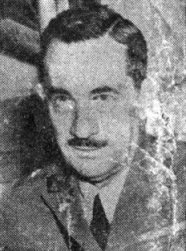
 First man to be sworn into the Regular Army in this Theater was Pvt. Johnny H. Head of the 100th Station Hospital,
New Delhi. Above Head takes the oath from Capt. Russell E. Streeter.
First man to be sworn into the Regular Army in this Theater was Pvt. Johnny H. Head of the 100th Station Hospital,
New Delhi. Above Head takes the oath from Capt. Russell E. Streeter.
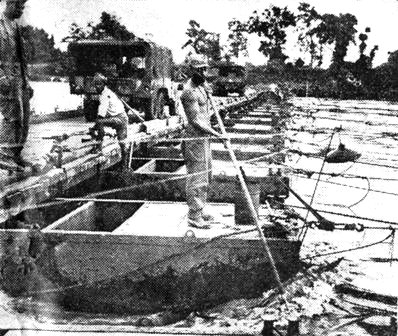 Pvt. James Roberts of Chicago handles a boat hook while standing on the end of the ponton bridge to keep the
debris from piling up.
Pvt. James Roberts of Chicago handles a boat hook while standing on the end of the ponton bridge to keep the
debris from piling up.
 Here are the three B-29 survivors of a plane shot down over Singapore January 11. They are shown relaxing with
a drink at the Raffles Hotel in Singapore. Left to right: Lt. E. C. Salzman; Brig. Gen. William H. Tunner, head of
ICD-ATC; Maj. Donald J. Humphrey and Lt. Col. Red Forman, who piloted Lt. Gen. Wheeler's C-54 to Singapore.
Salzman was the engineer aboard the plane, Humphrey the pilot, and Duffy the bombardier.
Here are the three B-29 survivors of a plane shot down over Singapore January 11. They are shown relaxing with
a drink at the Raffles Hotel in Singapore. Left to right: Lt. E. C. Salzman; Brig. Gen. William H. Tunner, head of
ICD-ATC; Maj. Donald J. Humphrey and Lt. Col. Red Forman, who piloted Lt. Gen. Wheeler's C-54 to Singapore.
Salzman was the engineer aboard the plane, Humphrey the pilot, and Duffy the bombardier.